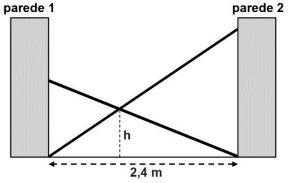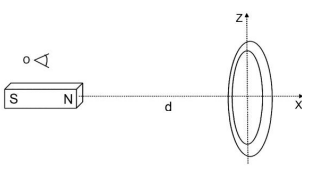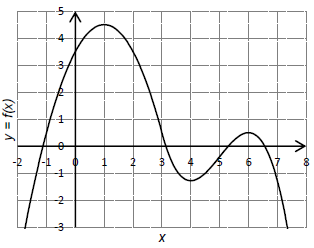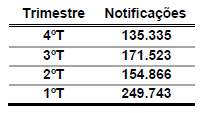Questões Militares
Comentadas para pm-pr
Foram encontradas 632 questões
Resolva questões gratuitamente!
Junte-se a mais de 4 milhões de concurseiros!
1. Clara dos Anjos é uma moça que tem dezessete anos no início da trama; viveu toda sua vida no subúrbio e foi criada de maneira rígida, sem ter permissão para sair de casa sozinha.
2. Salustiana Baeta de Azevedo é uma mulher que se julga superior a todos os outros habitantes do subúrbio e que protege seu filho Cassi Jones mesmo contra a vontade do marido.
3. Marramaque é um pequeno funcionário público, padrinho de Clara e amigo do pai dela; desde o início da trama, Marramaque demonstra repulsa por Cassi Jones, que arquiteta seu assassinato.
4. Cassi Jones é um cantador de modinhas malandro típico do Rio de Janeiro do início do século XX, capaz de circular com desenvoltura tanto no subúrbio, onde vive, como no centro da cidade.
Assinale a alternativa correta.


CARDOSO, Oldimar. Tudo é história (9o ano). S. Paulo: Ática, 2006, p. 231.
A partir dos elementos da charge e dos conhecimentos sobre o período da ditadura civil-militar no Brasil (1964-1985), identifique as seguintes afirmativas como verdadeiras (V) ou falsas (F):
( ) A charge faz referência ao símbolo da suástica nazista, pois iguala a cassação de direitos civis e políticos que ocorreu após o golpe militar brasileiro com a cassação de direitos civis dos judeus alemães no regime nazista. ( ) A direita na América Latina, durante o período da Guerra Fria (1945-1989), recebeu apoio da União Soviética para instituir governos autoritários que afirmavam proteger o bem maior da população contra inimigos comunistas. ( ) A charge faz referência ao caráter do governo instituído ser de direita, para proteger o país de uma alegada “ameaça comunista”, que foi associada pelos militares e seus apoiadores ao presidente deposto João Goulart e demais grupos de esquerda. ( ) Eventos como a Revolução Cubana (1959) não somente inspiraram diversos movimentos de esquerda antes e depois do golpe militar, como impulsionaram os Estados Unidos para o estreitamento de laços com a direita na América Latina.
Assinale a alternativa que apresenta a sequência correta, de cima para baixo.
 sua força eletromotriz, o
comportamento característico é
descrito pela conhecida equação do
gerador, que fornece a diferença de
potencial
sua força eletromotriz, o
comportamento característico é
descrito pela conhecida equação do
gerador, que fornece a diferença de
potencial  em seus terminais A e
B em função da corrente i fornecida
por ele. Um dado gerador tem a
curva característica mostrada no
gráfico ao lado.
em seus terminais A e
B em função da corrente i fornecida
por ele. Um dado gerador tem a
curva característica mostrada no
gráfico ao lado. A partir do circuito e do gráfico apresentados, assinale a alternativa correta para a potência dissipada internamente na fonte quando esta fornece uma corrente de 2,0 mA.

 onde ε é a força eletromotriz induzida em um circuito, ∅ é o fluxo magnético através desse circuito e t é o
tempo.
onde ε é a força eletromotriz induzida em um circuito, ∅ é o fluxo magnético através desse circuito e t é o
tempo. Considere a figura ao lado, que representa um ímã próximo a um anel condutor e um observador na posição O. O ímã pode se deslocar ao longo do eixo do anel e a distância entre o polo norte e o centro do anel é d. Tendo em vista essas informações, identifique as seguintes afirmativas como verdadeiras (V) ou falsas (F):
( ) Mantendo-se a distância d constante se observará o surgimento de uma corrente induzida no anel no sentido horário. ( ) Durante a aproximação do ímã à espira, observa-se o surgimento de uma corrente induzida no anel no sentido horário. ( ) Durante o afastamento do ímã em relação à espira, observa-se o surgimento de uma corrente induzida no anel no sentido horário. ( ) Girando-se o anel em torno do eixo z, observa-se o surgimento de uma corrente induzida.
Assinale a alternativa que apresenta a sequência correta, de cima para baixo.

 o
coeficiente de atrito cinético entre a superfície do plano inclinado e o objeto, assinale a alternativa correta para a
variação da energia cinética do objeto, em módulo, ao se mover do
ponto P, cuja velocidade em módulo é vP, ao ponto Q, onde sua
velocidade tem módulo vQ. Na resolução desse problema considere
o
coeficiente de atrito cinético entre a superfície do plano inclinado e o objeto, assinale a alternativa correta para a
variação da energia cinética do objeto, em módulo, ao se mover do
ponto P, cuja velocidade em módulo é vP, ao ponto Q, onde sua
velocidade tem módulo vQ. Na resolução desse problema considere  e
e  .
. 
SANTOS, M.; SILVEIRA, M. L. O Brasil – Território e sociedade no início do século XXI. Rio de Janeiro: Record, 2001, p. 279.
Com base na reflexão oferecida pelo texto e no conhecimento sobre geografia do Brasil, assinale a alternativa INCORRETA.

Com base na tabela e nos conhecimentos de Geografia Industrial, assinale a alternativa correta.

Sabendo que o maior segmento a ser percorrido no trajeto sugerido pelo GPS corresponde à distância de 345m, é correto afirmar que a distância total a ser percorrida é de
Six things I learned from riding in a Google self-driving car
1 - Human beings are terrible drivers.
We drink. We doze. We text. In the US, 30,000 people die from automobile accidents every year. Traffic crashes are the primary cause of death worldwide for people aged 15-24, and during a crash, 40% of drivers never even hit the brakes. We’re flawed organisms, barreling around at high speeds in vessels covered in glass, metal, distraction, and death. This is one of Google’s “moonshots” – to remove human error from a job which, for the past hundred years, has been entirely human.
2 - Google self-driving cars are timid.
The car we rode in did not strike me as dangerous. It drove slowly and deliberately, and I got the impression that it’s more likely to annoy other drivers than to harm them. In the early versions they tested on closed courses, the vehicles were programmed to be highly aggressive. Apparently during these tests, which involved obstacle courses full of traffic cones and inflatable crash-test objects, there were a lot of screeching brakes, roaring engines and terrified interns.
3 - They’re cute.
Google’s new fleet was intentionally designed to look adorable. Our brains are hardwired to treat inanimate (or animate) objects with greater care, caution, and reverence when they resemble a living thing. By turning self-driving cars into an adorable Skynet Marshmallow Bumper Bots, Google hopes to spiritually disarm other drivers. I also suspect the cuteness is used to quell some of the road rage that might emerge from being stuck behind one of these things. They’re intended as moderate-distance couriers, not openroad warriors, so their max speed is 25 miles per hour.
4 - It’s not done and it’s not perfect.
Some of the scenarios autonomous vehicles have the most trouble with are the same human beings have the most trouble with, such as traversing four-way stops or handling a yellow light. The cars use a mixture of 3D laser-mapping, GPS, and radar to analyze and interpret their surroundings, and the latest versions are fully electric with a range of about 100 miles. Despite the advantages over a human being in certain scenarios, however, these cars still aren’t ready for the real world. They can’t drive in the snow or heavy rain, and there’s a variety of complex situations they do not process well, such as passing through a construction zone. Google is hoping that, eventually, the cars will be able to handle all of this as well (or better) than a human could.
5 - I want this technology to succeed, like… yesterday.
I’m biased. Earlier this year my mom had a stroke. It damaged the visual cortex of her brain, and her vision was impaired to the point that she’ll probably never drive again. This reduced her from a fully-functional, independent human being with a career and a buzzing social life into someone who is homebound, disabled, and powerless. When discussing self-driving cars, people tend to ask many superficial questions. They ignore that 45% of disabled people in the US still work. They ignore that 95% of a car’s lifetime is spent parked. They ignore how this technology could transform the lives of the elderly, or eradicate the need for parking lots or garages or gas stations. They dismiss the entire concept because they don’t think a computer could ever be as good at merging on the freeway as they are. They ignore the great, big, beautiful picture: that this technology could make our lives so much better.
6 - It wasn’t an exhilarating ride, and that’s a good thing.
Riding in a self-driving car is not the cybernetic thrill ride one might expect. The car drives like a person, and after a few minutes you forget that you’re being driven autonomously. You forget that a robot is differentiating cars from pedestrians from mopeds from raccoons. You forget that millions of photons are being fired from a laser and interpreting, processing, and reacting to the hand signals of a cyclist. You forget that instead of an organic brain, which has had millions of years to evolve the cognitive ability to fumble its way through a four-way stop, you’re being piloted by an artificial one, which was birthed in less than a decade. The unfortunate part of something this transformative is the inevitable, ardent stupidity which is going to erupt from the general public. Even if in a few years self-driving cars are proven to be ten times safer than human-operated cars, all it’s going to take is one tragic accident and the public is going to lose their minds. There will be outrage. There will be politicizing. There will be hashtags. I say look at the bigger picture. All the self-driving cars currently on the road learn from one another, and possess 40 years of driving experience. And this technology is still in its infancy.
(Adapted from:: <http://theoatmeal.com/blog/google_self_driving_car>
Six things I learned from riding in a Google self-driving car
1 - Human beings are terrible drivers.
We drink. We doze. We text. In the US, 30,000 people die from automobile accidents every year. Traffic crashes are the primary cause of death worldwide for people aged 15-24, and during a crash, 40% of drivers never even hit the brakes. We’re flawed organisms, barreling around at high speeds in vessels covered in glass, metal, distraction, and death. This is one of Google’s “moonshots” – to remove human error from a job which, for the past hundred years, has been entirely human.
2 - Google self-driving cars are timid.
The car we rode in did not strike me as dangerous. It drove slowly and deliberately, and I got the impression that it’s more likely to annoy other drivers than to harm them. In the early versions they tested on closed courses, the vehicles were programmed to be highly aggressive. Apparently during these tests, which involved obstacle courses full of traffic cones and inflatable crash-test objects, there were a lot of screeching brakes, roaring engines and terrified interns.
3 - They’re cute.
Google’s new fleet was intentionally designed to look adorable. Our brains are hardwired to treat inanimate (or animate) objects with greater care, caution, and reverence when they resemble a living thing. By turning self-driving cars into an adorable Skynet Marshmallow Bumper Bots, Google hopes to spiritually disarm other drivers. I also suspect the cuteness is used to quell some of the road rage that might emerge from being stuck behind one of these things. They’re intended as moderate-distance couriers, not openroad warriors, so their max speed is 25 miles per hour.
4 - It’s not done and it’s not perfect.
Some of the scenarios autonomous vehicles have the most trouble with are the same human beings have the most trouble with, such as traversing four-way stops or handling a yellow light. The cars use a mixture of 3D laser-mapping, GPS, and radar to analyze and interpret their surroundings, and the latest versions are fully electric with a range of about 100 miles. Despite the advantages over a human being in certain scenarios, however, these cars still aren’t ready for the real world. They can’t drive in the snow or heavy rain, and there’s a variety of complex situations they do not process well, such as passing through a construction zone. Google is hoping that, eventually, the cars will be able to handle all of this as well (or better) than a human could.
5 - I want this technology to succeed, like… yesterday.
I’m biased. Earlier this year my mom had a stroke. It damaged the visual cortex of her brain, and her vision was impaired to the point that she’ll probably never drive again. This reduced her from a fully-functional, independent human being with a career and a buzzing social life into someone who is homebound, disabled, and powerless. When discussing self-driving cars, people tend to ask many superficial questions. They ignore that 45% of disabled people in the US still work. They ignore that 95% of a car’s lifetime is spent parked. They ignore how this technology could transform the lives of the elderly, or eradicate the need for parking lots or garages or gas stations. They dismiss the entire concept because they don’t think a computer could ever be as good at merging on the freeway as they are. They ignore the great, big, beautiful picture: that this technology could make our lives so much better.
6 - It wasn’t an exhilarating ride, and that’s a good thing.
Riding in a self-driving car is not the cybernetic thrill ride one might expect. The car drives like a person, and after a few minutes you forget that you’re being driven autonomously. You forget that a robot is differentiating cars from pedestrians from mopeds from raccoons. You forget that millions of photons are being fired from a laser and interpreting, processing, and reacting to the hand signals of a cyclist. You forget that instead of an organic brain, which has had millions of years to evolve the cognitive ability to fumble its way through a four-way stop, you’re being piloted by an artificial one, which was birthed in less than a decade. The unfortunate part of something this transformative is the inevitable, ardent stupidity which is going to erupt from the general public. Even if in a few years self-driving cars are proven to be ten times safer than human-operated cars, all it’s going to take is one tragic accident and the public is going to lose their minds. There will be outrage. There will be politicizing. There will be hashtags. I say look at the bigger picture. All the self-driving cars currently on the road learn from one another, and possess 40 years of driving experience. And this technology is still in its infancy.
(Adapted from:: <http://theoatmeal.com/blog/google_self_driving_car>
Six things I learned from riding in a Google self-driving car
1 - Human beings are terrible drivers.
We drink. We doze. We text. In the US, 30,000 people die from automobile accidents every year. Traffic crashes are the primary cause of death worldwide for people aged 15-24, and during a crash, 40% of drivers never even hit the brakes. We’re flawed organisms, barreling around at high speeds in vessels covered in glass, metal, distraction, and death. This is one of Google’s “moonshots” – to remove human error from a job which, for the past hundred years, has been entirely human.
2 - Google self-driving cars are timid.
The car we rode in did not strike me as dangerous. It drove slowly and deliberately, and I got the impression that it’s more likely to annoy other drivers than to harm them. In the early versions they tested on closed courses, the vehicles were programmed to be highly aggressive. Apparently during these tests, which involved obstacle courses full of traffic cones and inflatable crash-test objects, there were a lot of screeching brakes, roaring engines and terrified interns.
3 - They’re cute.
Google’s new fleet was intentionally designed to look adorable. Our brains are hardwired to treat inanimate (or animate) objects with greater care, caution, and reverence when they resemble a living thing. By turning self-driving cars into an adorable Skynet Marshmallow Bumper Bots, Google hopes to spiritually disarm other drivers. I also suspect the cuteness is used to quell some of the road rage that might emerge from being stuck behind one of these things. They’re intended as moderate-distance couriers, not openroad warriors, so their max speed is 25 miles per hour.
4 - It’s not done and it’s not perfect.
Some of the scenarios autonomous vehicles have the most trouble with are the same human beings have the most trouble with, such as traversing four-way stops or handling a yellow light. The cars use a mixture of 3D laser-mapping, GPS, and radar to analyze and interpret their surroundings, and the latest versions are fully electric with a range of about 100 miles. Despite the advantages over a human being in certain scenarios, however, these cars still aren’t ready for the real world. They can’t drive in the snow or heavy rain, and there’s a variety of complex situations they do not process well, such as passing through a construction zone. Google is hoping that, eventually, the cars will be able to handle all of this as well (or better) than a human could.
5 - I want this technology to succeed, like… yesterday.
I’m biased. Earlier this year my mom had a stroke. It damaged the visual cortex of her brain, and her vision was impaired to the point that she’ll probably never drive again. This reduced her from a fully-functional, independent human being with a career and a buzzing social life into someone who is homebound, disabled, and powerless. When discussing self-driving cars, people tend to ask many superficial questions. They ignore that 45% of disabled people in the US still work. They ignore that 95% of a car’s lifetime is spent parked. They ignore how this technology could transform the lives of the elderly, or eradicate the need for parking lots or garages or gas stations. They dismiss the entire concept because they don’t think a computer could ever be as good at merging on the freeway as they are. They ignore the great, big, beautiful picture: that this technology could make our lives so much better.
6 - It wasn’t an exhilarating ride, and that’s a good thing.
Riding in a self-driving car is not the cybernetic thrill ride one might expect. The car drives like a person, and after a few minutes you forget that you’re being driven autonomously. You forget that a robot is differentiating cars from pedestrians from mopeds from raccoons. You forget that millions of photons are being fired from a laser and interpreting, processing, and reacting to the hand signals of a cyclist. You forget that instead of an organic brain, which has had millions of years to evolve the cognitive ability to fumble its way through a four-way stop, you’re being piloted by an artificial one, which was birthed in less than a decade. The unfortunate part of something this transformative is the inevitable, ardent stupidity which is going to erupt from the general public. Even if in a few years self-driving cars are proven to be ten times safer than human-operated cars, all it’s going to take is one tragic accident and the public is going to lose their minds. There will be outrage. There will be politicizing. There will be hashtags. I say look at the bigger picture. All the self-driving cars currently on the road learn from one another, and possess 40 years of driving experience. And this technology is still in its infancy.
(Adapted from:: <http://theoatmeal.com/blog/google_self_driving_car>
1. Drinking before driving. 2. Sending a written message while driving. 3. Sleeping for a short period of time. 4. Hitting the brakes. 5. Speeding up.
According to the text, some human mistakes that happen before or during a car accident are:
A respeito da função representada no gráfico ao lado, considere as seguintes afirmativas:
1. A função é crescente no intervalo aberto (4,6).
2. A função tem um ponto de máximo em x=1.
3. Esse gráfico representa uma função injetora.
4. Esse gráfico representa uma função polinomial de terceiro grau.

Assinale a alternativa correta.

Dados – M (g mol-1 ): H = 1; C = 12; N = 14; O = 16.
Qual é o valor da massa molar (em g mol-1 ) desse composto?
